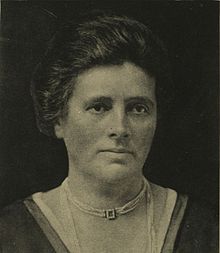Margaret Wintringham
| Margaret Wintringham | |
|---|---|

Wintringham in 1921
|
|
| Member of Parliament for Louth, Lincolnshire |
|
|
In office 22 September 1921 – 28 October 1924 |
|
| Prime Minister | David Lloyd George |
| Preceded by | Thomas Wintringham |
| Succeeded by | Arthur Heneage |
| Personal details | |
| Born |
Margaret Longbottom 4 August 1879 Keighley, West Riding of Yorkshire, UK |
| Died | 10 March 1955 (aged 75) |
| Political party | Liberal Party |
Margaret Wintringham (4 August 1879 – 10 March 1955), née Longbottom, was a British Liberal Party politician. She was the second woman to take her seat in the House of Commons of the United Kingdom.
Margaret Longbottom was born in Keighley, West Riding of Yorkshire, and educated at Bolton Road School, Silsden where her father was the head teacher, and then Keighley Girls' Grammar School. After training at Bedford Training College, she worked as a teacher, eventually becoming headmistress of a school in Grimsby. In 1903 she married Thomas Wintringham, a timber merchant.
They had no children, and Margaret Wintringham became a magistrate and a member of the Grimsby Education Committee. She was involved in many political movements, including the National Union of Women Workers, the British Temperance Association, the National Union of Societies for Equal Citizenship (NUSEC), the Women's Institute, the Townswomen's Guild and the Liberal Party.
When her husband was elected as Member of Parliament (MP) for Louth in Lincolnshire, she moved with him from Grimsby to Louth and remained politically active. When Thomas Wintringham died in 1921, she was selected as the Liberal candidate to replace him, and on 22 September she won the 1921 Louth by-election, becoming the first ever female Liberal MP and the third woman elected to the House of Commons. The first woman to be elected had been the abstentionist Constance Markievicz in 1918; the first to take her seat was the Conservative Nancy Astor, elected in 1919.
...
Wikipedia
